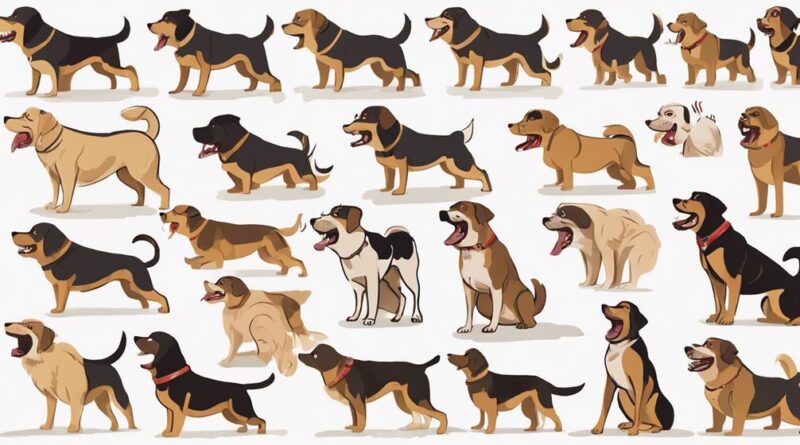9 Best Insights Into Dog Growling Communication
Coincidentally, you've likely heard your dog growl at some point, but do you truly understand what they're trying to communicate?
Dog growling is a nuanced form of expression that can reveal a lot about their feelings and needs. By deciphering the various types of growls and accompanying body language cues, you can gain valuable insights into your furry companion's emotions.
Delving deeper into these insights could enhance your relationship with your dog and foster better communication between you both.
Types of Dog Growls
Understanding the various types of dog growls can provide valuable insights into their communication signals. Dogs use growling as a form of canine communication to express a range of emotions and intentions. By familiarizing yourself with these different types of growls, you can better understand your furry friend's behavioral cues and potentially engage in behavior modification to address any underlying issues.
One common type of growl is the playful growl, often accompanied by a wagging tail and a relaxed body posture. This type of growl is usually part of a playful interaction and isn't a cause for concern. On the other hand, a low-pitched, sustained growl may indicate discomfort, fear, or aggression. It's essential to pay attention to the context and body language cues accompanying the growl to interpret its meaning accurately.
Body Language Cues
Body language cues play a crucial role in deciphering a dog's emotional state and intentions during communication. When observing canine behavior, paying attention to nonverbal cues is essential. Dogs use their bodies to express a wide range of emotions, from excitement to fear or aggression. For instance, a dog wagging its tail loosely with a relaxed body posture is likely showing friendliness. On the other hand, a dog with a tense body, raised fur, and a fixed gaze may be indicating discomfort or a readiness to defend itself.
Understanding these nonverbal cues can help prevent misunderstandings and potential conflicts. A dog's body language provides valuable insights into how they're feeling in different situations. By recognizing signs like a lowered head, ears pinned back, or a stiff body, you can adjust your approach accordingly to ensure positive interactions. Remember, dogs communicate primarily through their body language, so being attentive to these cues is crucial for fostering a harmonious relationship.
Contextual Understanding
When interpreting dog behavior, paying attention to the context in which communication occurs is key to deciphering their intentions and emotional state accurately. Environmental triggers play a crucial role in influencing a dog's behavior and can lead to different behavioral responses. For instance, a dog growling when near their food bowl may indicate resource guarding, while growling during play suggests a more playful interaction. Understanding these environmental triggers can help you respond appropriately to your furry companion.
Canine socialization also plays a significant role in how dogs communicate through growling. Dogs that have been well-socialized from a young age are more likely to exhibit controlled and appropriate emotional responses during interactions. On the other hand, dogs with limited socialization may growl out of fear or anxiety when faced with unfamiliar situations.
Aggression Vs. Playfulness
In distinguishing between aggression and playfulness in dogs, it's essential to observe their body language and vocal cues carefully. Dogs use a variety of signals to communicate their intentions, and understanding these cues is crucial in interpreting their behavior accurately.
Here are some key points to help you differentiate between aggression and playfulness:
- Playful banter: Dogs engaging in play will often exhibit loose, relaxed body language with wagging tails and play bows.
- Aggressive warning: Aggressive dogs may display stiff body posture, raised fur, and intense stares as a warning sign.
- Misinterpreted signals: Sometimes, playful behaviors such as rough play or playful growls can be misunderstood as aggression if not assessed in the right context.
- Playful growls: Dogs can emit growls during play that are softer, higher-pitched, and accompanied by a relaxed facial expression.
- Context matters: Consider the environment and the dog's overall demeanor to accurately differentiate between playful interactions and potentially aggressive behavior.
Vocalization Variations
Understanding the nuances of dog vocalizations can provide valuable insights into their communication patterns and emotional states. When it comes to vocalization variations, dogs exhibit a range of behaviors through pitch changes, intensity levels, frequency patterns, and duration differences. Paying attention to these variations can help you better understand what your dog is trying to communicate.
Pitch changes in a dog's vocalizations can indicate different emotional states. A high-pitched bark may signal excitement or alertness, while a low-pitched growl can indicate aggression or discomfort. Similarly, intensity levels can vary, with softer whimpers often expressing fear or anxiety, and louder barks showing assertiveness or warning.
Frequency patterns and duration differences also play a significant role in dog vocalizations. Dogs may bark rapidly in short bursts to convey eagerness or playfulness, while prolonged howling can suggest loneliness or distress. By observing these vocalization variations, you can gain valuable insights into your dog's feelings and effectively communicate with them.
Communicating Fear or Pain
Noticing changes in your dog's vocalizations can provide crucial insights into their communication of fear or pain. When your furry friend is feeling scared or in discomfort, their growls may carry specific signals that you should pay attention to. Here are some key points to help you understand your dog's communication better:
- Fear signals: Dogs may produce high-pitched growls when they're feeling fearful or anxious. These growls may be accompanied by other body language cues such as cowering, trembling, or attempts to escape the situation.
- Pain indicators: If your dog is in pain, their growls may sound different from their usual playful or warning growls. Listen for growls that are more continuous, intense, or accompanied by yelps or whimpers.
- Body language: Pay attention to your dog's overall body language when they growl to determine if they're expressing fear or pain. Signs like ears pinned back, tail tucked, or avoiding eye contact can indicate fear or discomfort.
- Context: Understanding the context in which your dog is growling is essential. If they growl when touched in a specific area, it could be a sign of pain. Conversely, growling when approached by a stranger may indicate fear.
- Veterinary consultation: If you suspect that your dog is communicating fear or pain through their growls, it's crucial to consult with a veterinarian to rule out any underlying medical issues and address behavioral concerns promptly.
Training and Reactivity

When training your dog to manage reactivity, focus on positive reinforcement techniques to encourage desired behaviors. Reactivity management involves teaching your dog to respond calmly in situations that usually trigger a reactive response. Behavior modification plays a crucial role in this process by reshaping your dog's reactions to stimuli.
To begin reactivity management, identify the specific triggers that cause your dog to react negatively. Once you understand these triggers, you can gradually expose your dog to them in a controlled setting. Use positive reinforcement techniques like treats, toys, or praise to reward your dog for displaying calm behavior in the presence of triggers. Consistency is key; practice regularly to reinforce positive responses.
Additionally, consider seeking professional help from a certified dog trainer or behaviorist if you encounter difficulties in managing your dog's reactivity. These experts can provide tailored strategies and guidance to address your dog's specific needs effectively. Remember, with patience and dedication, you can help your dog overcome reactivity and develop more positive behaviors.
Seeking Professional Help
For effective guidance in managing your dog's reactivity, seeking assistance from a certified dog trainer or behaviorist is highly recommended. These professionals have the expertise to help you understand your dog's behavior and develop effective strategies for behavior modification. Here are five key reasons why seeking professional help is beneficial:
- Personalized Training: A certified trainer or behaviorist can tailor a training plan based on your dog's specific needs and temperament.
- Expert Knowledge: Professionals are well-versed in canine psychology, allowing them to interpret your dog's behavior accurately and address underlying issues.
- Safe Environment: Working with a professional ensures that training sessions are conducted in a safe and controlled environment, minimizing risks.
- Consistent Support: Trainers provide ongoing support and guidance, helping you stay on track with your dog's behavior modification program.
- Effective Results: Professional guidance increases the likelihood of successful behavior modification, leading to a harmonious relationship between you and your furry companion.
Frequently Asked Questions
Can Certain Breeds of Dogs Be More Prone to Growling Than Others?
Some dog breeds may have a tendency to growl more than others due to their genetic makeup and history.
Socialization plays a crucial role in how a dog expresses itself, regardless of breed tendencies.
Training techniques and understanding canine body language are essential in addressing growling behavior in any breed.
How Can a Dog Owner Effectively Differentiate Between a Growl Signaling Aggression Versus Playfulness?
When trying to differentiate between a growl signaling aggression versus playfulness, pay close attention to your pup's body language. If their tail is wagging, they may be growling playfully. Also, consider the tone of the growl – a low, continuous growl might indicate aggression, while a higher-pitched one could signal excitement.
Through training and observation, you'll become more adept at understanding your dog's different growls and what they mean in various situations.
Are There Any Specific Vocalization Variations That Indicate a Dog Is Feeling Anxious or Stressed?
When your dog feels anxious or stressed, you may notice changes in their body language and vocal cues. They might whine, whimper, or have a higher-pitched bark. Pay attention to flattened ears, a tucked tail, or avoiding eye contact.
To help them, use training techniques like desensitization and counterconditioning. Look for calming signals such as yawning, lip licking, or turning away. Understanding these cues can help you support your pup when they're feeling uneasy.
Can Growling Be a Learned Behavior From Other Dogs in a Household?
Growling in dogs can indeed be a learned behavior within a household. Social learning and behavior modification play big roles in how dogs pick up on growling tendencies from other dogs. Household dynamics can influence this, as dogs observe and mimic behaviors of their canine companions.
If one dog growls in a specific situation, other dogs may learn to do the same, especially if they see it as an effective form of communication.
Are There Any Common Mistakes That Dog Owners Make When Trying to Address Growling Behavior in Their Pets?
When trying to address your dog's growling, common mistakes include misunderstanding cues and using incorrect training methods. It's essential to focus on behavior modification rather than punishment.
Miscommunication signals can occur if you don't pay attention to your dog's body language. Be observant and seek professional guidance for effective strategies.
Conclusion
Remember, understanding your dog's growling is key to effective communication. By recognizing the different types of growls, body language cues, and contextual clues, you can better interpret what your dog is trying to tell you.
Whether it's a playful growl during a game or a warning growl when feeling threatened, paying attention to your dog's vocalizations can help strengthen your bond and prevent misunderstandings.
Always seek professional help if you're unsure or concerned about your dog's behavior.
